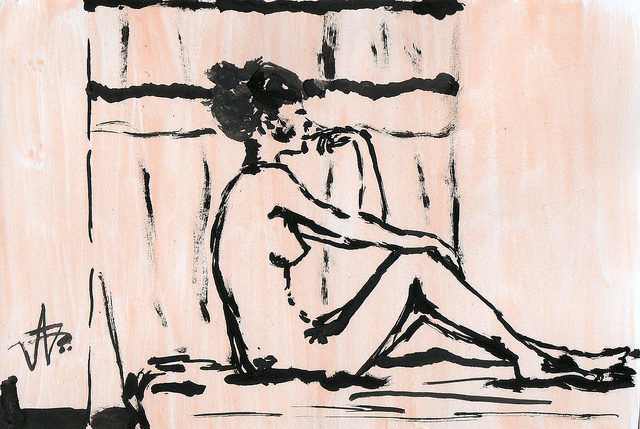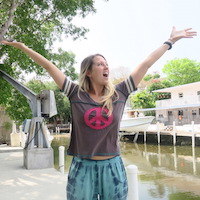 get elephant's newsletter
get elephant's newsletterI remember walking past my mirror and catching sight of it. It stared back at me, and after gazing at it for quite some time, it began to resemble a face.
Yep, my belly looked like a face. My top two rolls resembled two closed eyes, and the bottom looked like a smile; the belly-button, a nose.
There was my belly, smiling at me. I glared back at it with resentment. As far back as I can remember, I’ve had a stomach. (No way, you have a stomach?!) Okay, I mean a protruding, “pudgy” stomach. One with rolls that are thick and squishy and not big fans of crunches or sit-ups. One with skin folds that refuse to disappear, no matter how much I’ve begged and pleaded, or pushup-ed and burpee-d my way through fitness classes.
For years and years, my belly was my enemy. I never accepted my weight, either. I was so stuck on what healthy “should” look like, never once considering what healthy might feel like to me. I struggled greatly with my image and constantly worried about how others perceived me. “If I could just have a flat stomach, my problems would be solved! Why can’t I look like so and so, and have a smaller stomach like her?!”
My belly was the bane of my existence. My body image was incredibly skewed.
But I continued to view it the same way. Day after day, I let my middle control my emotions, thoughts, and feelings as though it were a separate entity from my body. Often, I wanted to escape it. As though my body weren’t whole. As though I wasn’t normal. This led to a harmful cycle of constantly waiting for a new beginning. I was always waiting for the “next day” to eat healthier, to view my body differently, to start over. I was proficient at starting over. I internally battled with the external image of my body, not fully understanding how interrelated the two actually are.
I remember walking aimlessly around New York City, silently screaming on the corner of Hudson and West 11thstreet, pleading for some kind of connection with others. I felt hopeless and desperate because I couldn’t better my body image, let alone come to some kind of compromise with meal times-and my rising abdomen. I truly felt like food was my open wound, incapable of being healed. My belly: the Band-Aid that wouldn’t stick.
It was around that time when I ventured over to a yoga class and began to practice again. I hadn’t in years. My interest in wanting to better my body image took me from Asana practice to exploring meditation and mindfulness, to reading up on inspirational authors and speakers like Pema Chödrön, Liz Gilbert, and the Dalai Lama. I decided to take one of Chödrön’s courses online and I heard her say this
:
:
“We are equally hooked by pleasant or unpleasant [experiences]. Continually caught in the [cycle] of hope and fear. When you notice you’re hooked, go beyond hope and fear, pleasure and pain, and choose a fresh alternative.
Then say to yourself, over and over again, even shout it out loud until you believe it: I think that what I know is true, but I will entertain that it is fiction.”
Boom. When I heard her say this aloud, bells went off in my mind, pianos played, angels sang, champagne bottles popped, and my belly rumbled. So this means I don’t have to think about my stomach the way that I always do? There’s another option? A fresh alternative? What?!
Yes. Yes, indeed. By viewing my body through the lens of a beginner’s mind, I’d be able to choose a fresh alternative to the same self-deprecating ways I’d always perceived my body. This allowed for the spaciousness to view my midriff as something different, and in a non-judgmental way. Also, in doing so, I am not escaping how I feel about my belly, but rather, I am choosing to be aware of what is there, and not judge it.
Dr. Jon Kabat-Zinn, founding Executive Director of the Center for Mindfulness in Medicine, Health Care, and Society at the University of Massachusetts Medical School, says that “Our minds are full of our expertise, but it leaves us without any realm for new possibilities.” Instead of staying enemies with our “hated” body part, why not choose a fresh alternative and shake hands with it? Be curious about it? Explore it? Maybe even befriend it?
Since listening to Chödrön’s brilliant talk, I’ve developed a daily mindfulness practice that has allowed my stomach to feel recognized and met in a way that it has not otherwise experienced. This has benefited my body image in tremendous ways and been profoundly healing for my psyche!
Here is a “Body Awareness Practice” that has greatly helped me in my journey with self-love:
Close your eyes, or soften your gaze, looking down the tip of your nose. Think about an area of your body that you tend to want to change, one that you’ve heard yourself say is a “problem area.”
Take three deep breaths at your own pace, and then bring your awareness to that portion of your body. If it is available to you, place one hand on that area, and send your breath there. Allow the breath to flow naturally without controlling it.
Think about how that part of your body physically feels. Focusing on the physical sensation of that body part, versus your judgements (opinions) about it.
Do you notice a slight change in temperature beneath your hand, on the chosen area? Are there any sensations of feeling beneath the skin? Do you notice the muscles or bones that lie there? Can you feel your breath moving through that part of the body? Notice what is there to notice, without judgement, being interested, curious, and drawing yourself into the experience of exploring your body part without putting a label on it (skinny/fat/strong/weak).
Now take three deep breaths at your own pace. Notice the breath moving through the chosen area of focus.
Repeat to yourself three times: “I believe that what I know is true, but I will entertain that it is fiction.”
Relephant Read:
The Healing Potential of Ashtanga Yoga.
~
Author: Eileen Daley
Image: Eleazar Fuentes/Flickr
Apprentice Editor: Tess Drudy; Editor: Emily Bartran

No comments:
Post a Comment